Energy-Efficient and QoS-Aware Computation Offloading in GEO/LEO Hybrid Satellite Networks
Abstract
1. Introduction
1.1. Related Works
1.2. Motivations
1.3. Novelty and Contributions
- Constructing a partial offloading model for GEO/LEO hybrid satellite networks, which aims to minimize the total energy consumption of the networks while guaranteeing QoS constraints of satellite missions.
- Transforming the partial computation offloading problem into the MCMF problem and proposing the SSPCO method to obtain the computation offloading decision in polynomial time.
- Performing extensive numerical experiments to demonstrate the effectiveness of the proposed SSPCO method. The results show that SSPCO achieves significant performance superiority compared with other benchmark strategies in the total energy consumption of the satellite networks, QoS violation degree, and algorithm running time.
2. Materials and Methods
2.1. System Model
2.1.1. Offloading Framework
2.1.2. Time Model
2.1.3. Energy Consumption Model
2.1.4. Problem Formulation
2.2. Computation Offloading Method Based on Minimum Cost Maximum Flow
2.2.1. Overview of MCMF
2.2.2. Transformation of Computation Offloading Problem into Minimum Cost Maximum Flow Problem
- Source node: the source node (S) is a virtual node that can satisfy the single-source single-sink condition in solving the MCMF problems.
- LEO node: the LEO node () denotes the LEO satellite in GEO/LEO hybrid satellite networks.
- GEO node: the GEO node () denotes the GEO satellite in GEO/LEO hybrid satellite networks. Each node has an edge from the LEO node in its coverage area, and the amount of the flow on the edge indicates the amount of mission data offloaded from the LEO satellite to the GEO satellite.
- Sink node: the sink node (T) is a virtual node that is introduced to satisfy the single-source single-sink requirement when solving the MCMF problem.
- Since there may be several missions in LEO satellites, the satellite-level granularity modeling shown in Figure 3 cannot generate mission-level offloading decisions;
- The network shown in Figure 3 can only represent the process of missions offloaded to GEO satellites and cannot represent the process of missions processed on LEO satellites;
- Due to the limited computing and storage resources of LEO and GEO satellites, the offloading of several missions may fail. However, the network shown in Figure 3 cannot indicate mission offloading failures.
- Mission node: the mission node () represents the missions generated on or accessed from LEO satellites and different LEO nodes have different numbers of mission nodes. By adding mission nodes, finer-grained mission-level offloading decisions can be generated.
- Self node: the self node () indicates the process of missions processed on LEO satellites, and all mission nodes are connected to the self node.
- U node: when there is a flow passing through the edge connecting a certain mission node and the U node (U), it means that the processing time of the mission is greater than its QoS constraint, indicating that the offloading has failed.
- : we set the capacity to be the sum of the amount of data of all missions on the LEO node. Since there is no actual consumption, the unit cost is set to zero, which can be given by
- : we set the capacity to the amount of data of the mission node v. And the unit cost is set to zero as there is no actual consumption, which can be expressed as
- : the maximum amount of mission data that can be offloaded to the GEO satellite is calculated based on the QoS constraint and the processing density, and the capacity is set to this calculated value. We also set the unit cost to the sum of the unit transmission energy consumption and the unit computational energy consumed by the GEO satellite, as shown in Equation (26).
- : we calculate the maximum amount of mission data that can be processed on the LEO satellite based on the QoS constraint and the processing density, and set the capacity to this calculated value. The unit computational energy consumed by the LEO satellite is mapped to the unit cost, as shown in Equation (28).
- : the capacity of this edge is set to Y, and Y needs to be greater than the total sum of the amount of the mission data, which is to ensure that failed missions can successfully flow to the sink node, T. In addition, the unit cost is set to K, and K is greater than the unit energy consumption of all offloaded missions. This is because the proposed SSPCO method selects the path with the minimum cost while finding the shortest augmenting path. If the unit cost of is small, SSPCO will give up offloading missions to GEO satellite nodes or self nodes and offload to U nodes instead, which leads to offloading failure. The equation is as follows
- : we set the capacity to a larger value, Z, to ensure that the missions can be successfully offloaded to the sink node, T. Since the mission processing result is much smaller than the original amount of data, we neglect the energy consumed by the result return and set the unit cost to zero. Thus, we can obtain Equation (32).
- : we set the capacity to X to guarantee that the missions processed on LEO satellites can successfully flow to the sink node, T, and the unit cost is set to zero since there is no additional consumption. Thus, we can obtain Equation (34).
- : similar to the capacity definition of , the capacity of this edge is set to , which is also carried out to ensure that the failed missions can successfully flow to the sink node, T, and the unit cost is set to zero since there is no actual consumption, so that Equation (36) can be obtained.
2.2.3. Successive Shortest Path-Based Computation Method
| Algorithm 1 Successive shortest path-based computation offloading algorithm |
input: the set of on-board missions, GEO/LEO satellite processing capacity, channel bandwidth, and channel gain; output: offloading decision for on-board missions;
|
3. Results
3.1. Experiment Setup
- GEO offloading computing (GOC): all missions are offloaded to GEO satellites for processing;
- LEO offloading computing (LOC): all missions are processed on LEO satellites;
- Genetic algorithm-based computation offloading (GACO) method [31]. GACO is an optimization method inspired by biological evolution mechanisms. It simulates processes such as biological inheritance, mutation, and selection to perform iterative searches for the optimal solution. In GACO, the fitness of individuals is evaluated in each iteration according to a fitness function (identical to our objective function), with superior individuals having a higher chance of being selected to generate the next generation.
- Particle swarm optimization-based computation offloading (PSOCO) method [32]. PSOCO is a swarm intelligence optimization algorithm that simulates the foraging behavior of bird flocks. In PSOCO, each solution in the search space is considered a ’particle’, and all particles move iteratively in the search space to find the optimal solution. The velocity and direction of each particle’s movement are influenced by its individual best experience and the overall best experience of the swarm. Like GACO, the fitness function of PSOCO is identical to our objective function.
3.2. Experiment Result
3.2.1. Energy Consumption and Processing Delay
3.2.2. Influence of Number of On-Board Missions
3.2.3. Influence of QoS
4. Discussion
4.1. Impact of Increasing Satellite Number
4.2. Limitations and Future Works
5. Conclusions
Author Contributions
Funding
Institutional Review Board Statement
Informed Consent Statement
Data Availability Statement
Conflicts of Interest
References
- Cao, X.; Yang, B.; Shen, Y.; Yuen, C.; Zhang, Y.; Han, Z.; Poor, H.V.; Hanzo, L. Edge-Assisted Multi-Layer Offloading Optimization of LEO Satellite-Terrestrial Integrated Networks. IEEE J. Sel. Areas Commun. 2022, 41, 381–398. [Google Scholar] [CrossRef]
- Denby, B.; Lucia, B. Orbital edge computing: Nanosatellite constellations as a new class of computer system. In Proceedings of the Twenty-Fifth International Conference on Architectural Support for Programming Languages and Operating Systems, Lausanne, Switzerland, 16–20 March 2020; pp. 939–954. [Google Scholar]
- Pfandzelter, T.; Hasenburg, J.; Bermbach, D. Towards a computing platform for the LEO edge. In Proceedings of the 4th International Workshop on Edge Systems, Analytics and Networking, Online, 26 April 2021; pp. 43–48. [Google Scholar]
- Li, Q.; Wang, S.; Ma, X.; Sun, Q.; Wang, H.; Cao, S.; Yang, F. Service coverage for satellite edge computing. IEEE Internet Things J. 2021, 9, 695–705. [Google Scholar] [CrossRef]
- Qin, J.; Guo, X.; Ma, X.; Li, X.; Yang, J. Application and Performance Evaluation of Resource Pool Architecture in Satellite Edge Computing. Aerospace 2022, 9, 451. [Google Scholar] [CrossRef]
- Zhang, Y.; Chen, C.; Liu, L.; Lan, D.; Jiang, H.; Wan, S. Aerial Edge Computing on Orbit: A Task Offloading and Allocation Scheme. IEEE Trans. Netw. Sci. Eng. 2022, 10, 275–285. [Google Scholar] [CrossRef]
- Tang, Q.; Fei, Z.; Li, B.; Han, Z. Computation offloading in LEO satellite networks with hybrid cloud and edge computing. IEEE Internet Things J. 2021, 8, 9164–9176. [Google Scholar] [CrossRef]
- Wei, D.; Xi, N.; Ma, J.; He, L. UAV-assisted privacy-preserving online computation offloading for internet of things. Remote Sens. 2021, 13, 4853. [Google Scholar] [CrossRef]
- Lin, L.; Liao, X.; Jin, H.; Li, P. Computation offloading toward edge computing. Proc. IEEE 2019, 107, 1584–1607. [Google Scholar] [CrossRef]
- Lin, H.; Zeadally, S.; Chen, Z.; Labiod, H.; Wang, L. A survey on computation offloading modeling for edge computing. J. Netw. Comput. Appl. 2020, 169, 102781. [Google Scholar] [CrossRef]
- He, Y.; Zhai, D.; Huang, F.; Wang, D.; Tang, X.; Zhang, R. Joint task offloading, resource allocation, and security assurance for mobile edge computing-enabled UAV-assisted VANETs. Remote Sens. 2021, 13, 1547. [Google Scholar] [CrossRef]
- Zhai, Y.; Bao, T.; Zhu, L.; Shen, M.; Du, X.; Guizani, M. Toward reinforcement-learning-based service deployment of 5G mobile edge computing with request-aware scheduling. IEEE Wirel. Commun. 2020, 27, 84–91. [Google Scholar] [CrossRef]
- Cassará, P.; Gotta, A.; Marchese, M.; Patrone, F. Orbital edge offloading on mega-LEO satellite constellations for equal access to computing. IEEE Commun. Mag. 2022, 60, 32–36. [Google Scholar] [CrossRef]
- Mao, B.; Tang, F.; Kawamoto, Y.; Kato, N. Optimizing computation offloading in satellite-UAV-served 6G IoT: A deep learning approach. IEEE Netw. 2021, 35, 102–108. [Google Scholar] [CrossRef]
- Li, Z.; Zhao, L.; Liu, Y.; Chen, X.; Chen, H.; Zheng, F.; Zhang, Y.; Wang, D.; Li, J.; Liu, J.; et al. Autonomous Mission Planning Method for Optical Imaging Satellites Based on Real-Time Cloud Cover Information. Remote Sens. 2022, 14, 2635. [Google Scholar] [CrossRef]
- Nishiyama, H.; Kudoh, D.; Kato, N.; Kadowaki, N. Load balancing and QoS provisioning based on congestion prediction for GEO/LEO hybrid satellite networks. Proc. IEEE 2011, 99, 1998–2007. [Google Scholar] [CrossRef]
- Li, D.; Wu, S.; Jiao, J.; Zhang, N.; Zhang, Q. Age-Aware Task Scheduling Scheme in Hybrid GEO-LEO Satellite Networks. In Proceedings of the GLOBECOM 2022–2022 IEEE Global Communications Conference, Rio de Janeiro, Brazil, 4–8 December 2022; IEEE: Piscataway, NJ, USA, 2022; pp. 5117–5122. [Google Scholar]
- Cui, G.; Duan, P.; Xu, L.; Wang, W. Latency Optimization for Hybrid GEO-LEO Satellite Assisted IoT Networks. IEEE Internet Things J. 2022, 10, 6286–6297. [Google Scholar] [CrossRef]
- Jia, M.; Zhang, L.; Wu, J.; Meng, S.; Guo, Q. Collaborative Satellite-Terrestrial Edge Computing Network for Everyone-Centric Customized Services. IEEE Netw. 2022. Early access. [Google Scholar] [CrossRef]
- Fang, H.; Jia, Y.; Wang, Y.; Zhao, Y.; Gao, Y.; Yang, X. Matching Game based Task Offloading and Resource Allocation Algorithm for Satellite Edge Computing Networks. In Proceedings of the 2022 International Symposium on Networks, Computers and Communications (ISNCC), Shenzhen, China, 19–22 July 2022; IEEE: Piscataway, NJ, USA, 2022; pp. 1–5. [Google Scholar]
- Wang, Y.; Lang, P.; Tian, D.; Zhou, J.; Duan, X.; Cao, Y.; Zhao, D. A game-based computation offloading method in vehicular multiaccess edge computing networks. IEEE Internet Things J. 2020, 7, 4987–4996. [Google Scholar] [CrossRef]
- Sun, Y.; Guo, X.; Song, J.; Zhou, S.; Jiang, Z.; Liu, X.; Niu, Z. Adaptive learning-based task offloading for vehicular edge computing systems. IEEE Trans. Veh. Technol. 2019, 68, 3061–3074. [Google Scholar] [CrossRef]
- Lv, W.; Yang, P.; Zheng, T.; Yi, B.; Ding, Y.; Wang, Q.; Deng, M. Energy Consumption and QoS-Aware Co-Offloading for Vehicular Edge Computing. IEEE Internet Things J. 2023, 10, 5214–5225. [Google Scholar] [CrossRef]
- Lyu, Y.; Liu, Z.; Fan, R.; Zhan, C.; Hu, H.; An, J. Optimal computation offloading in collaborative leo-iot enabled mec: A multi-agent deep reinforcement learning approach. IEEE Trans. Green Commun. Netw. 2022, 7, 996–1011. [Google Scholar] [CrossRef]
- Zhao, M.; Yu, J.J.; Li, W.T.; Liu, D.; Yao, S.; Feng, W.; She, C.; Quek, T.Q. Energy-aware task offloading and resource allocation for time-sensitive services in mobile edge computing systems. IEEE Trans. Veh. Technol. 2021, 70, 10925–10940. [Google Scholar] [CrossRef]
- Bi, J.; Yuan, H.; Duanmu, S.; Zhou, M.; Abusorrah, A. Energy-optimized partial computation offloading in mobile-edge computing with genetic simulated-annealing-based particle swarm optimization. IEEE Internet Things J. 2020, 8, 3774–3785. [Google Scholar] [CrossRef]
- Xin, J.; Meng, C.; D’Ariano, A.; Wang, D.; Negenborn, R.R. Mixed-integer nonlinear programming for energy-efficient container handling: Formulation and customized genetic algorithm. IEEE Trans. Intell. Transp. Syst. 2021, 23, 10542–10555. [Google Scholar] [CrossRef]
- Williamson, D.P. Network Flow Algorithms; Cambridge University Press: Cambridge, UK, 2019. [Google Scholar]
- Hu, Y.; Zhou, H.; de Laat, C.; Zhao, Z. Concurrent container scheduling on heterogeneous clusters with multi-resource constraints. Future Gener. Comput. Syst. 2020, 102, 562–573. [Google Scholar] [CrossRef]
- Vernet, M.; Drozdowski, M.; Pigné, Y.; Sanlaville, E. A theoretical and experimental study of a new algorithm for minimum cost flow in dynamic graphs. Discret. Appl. Math. 2021, 296, 203–216. [Google Scholar] [CrossRef]
- Materwala, H.; Ismail, L.; Shubair, R.M.; Buyya, R. Energy-SLA-aware genetic algorithm for edge–cloud integrated computation offloading in vehicular networks. Future Gener. Comput. Syst. 2022, 135, 205–222. [Google Scholar] [CrossRef]
- Luo, Q.; Li, C.; Luan, T.H.; Shi, W. Minimizing the delay and cost of computation offloading for vehicular edge computing. IEEE Trans. Serv. Comput. 2021, 15, 2897–2909. [Google Scholar] [CrossRef]
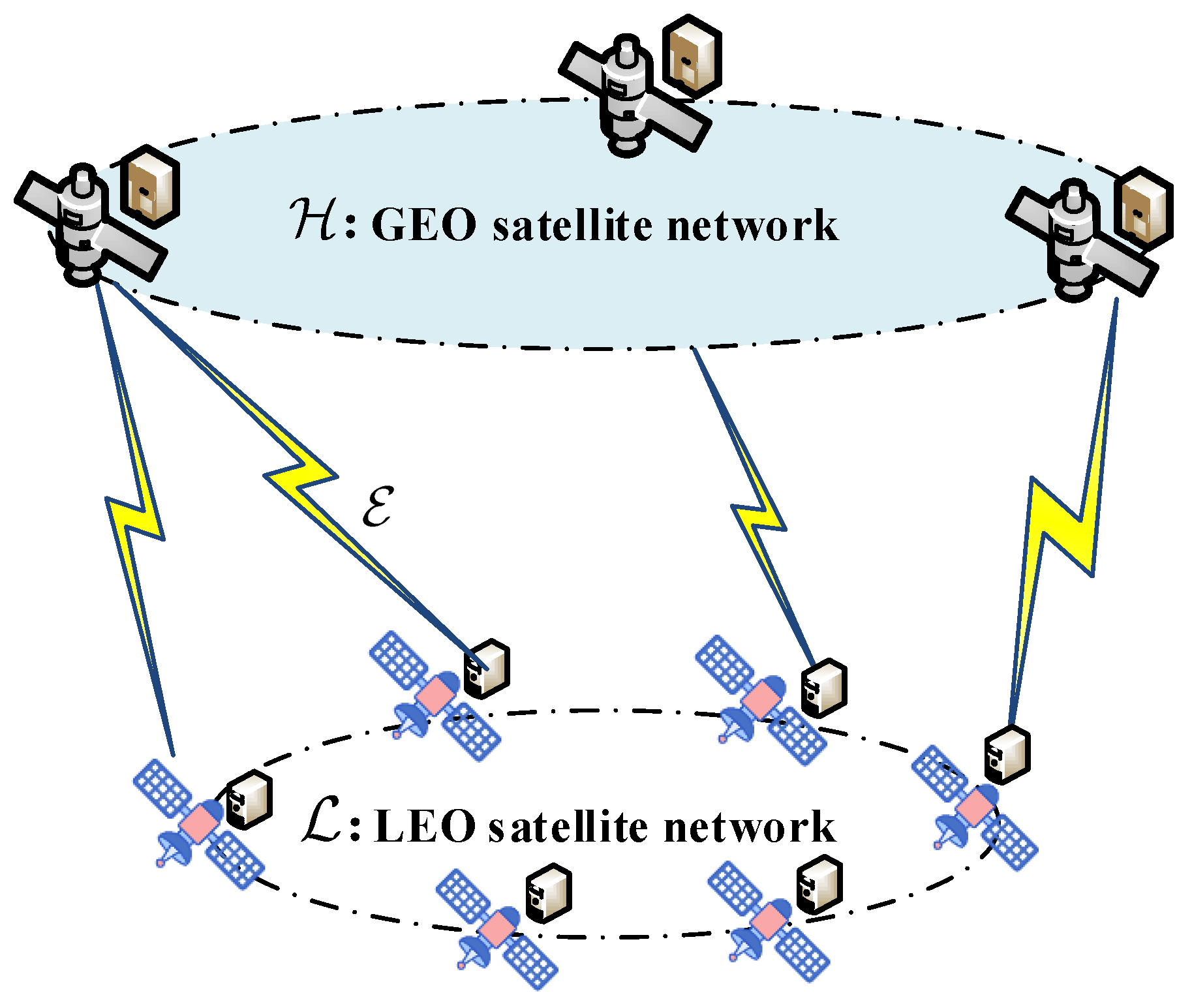

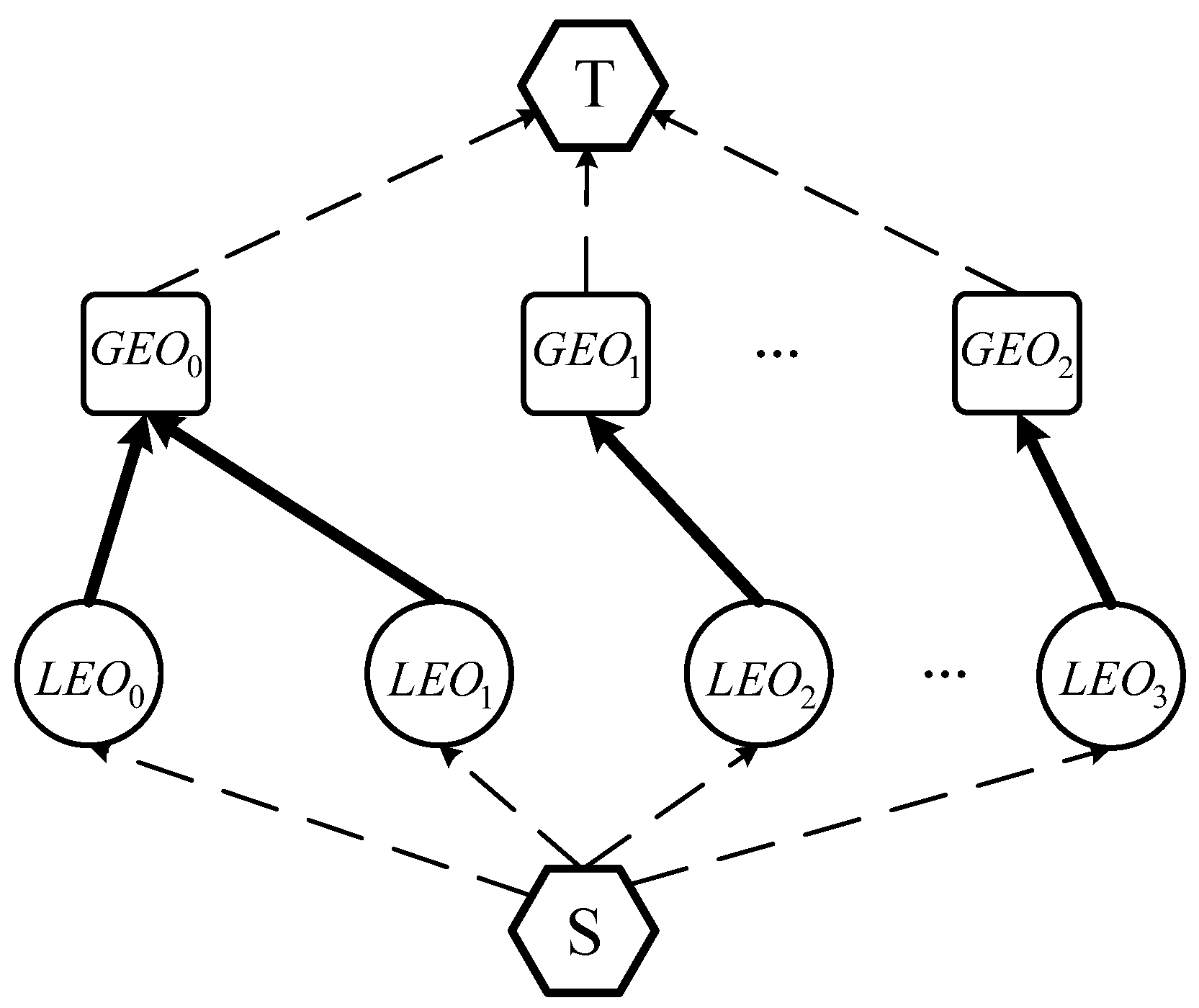
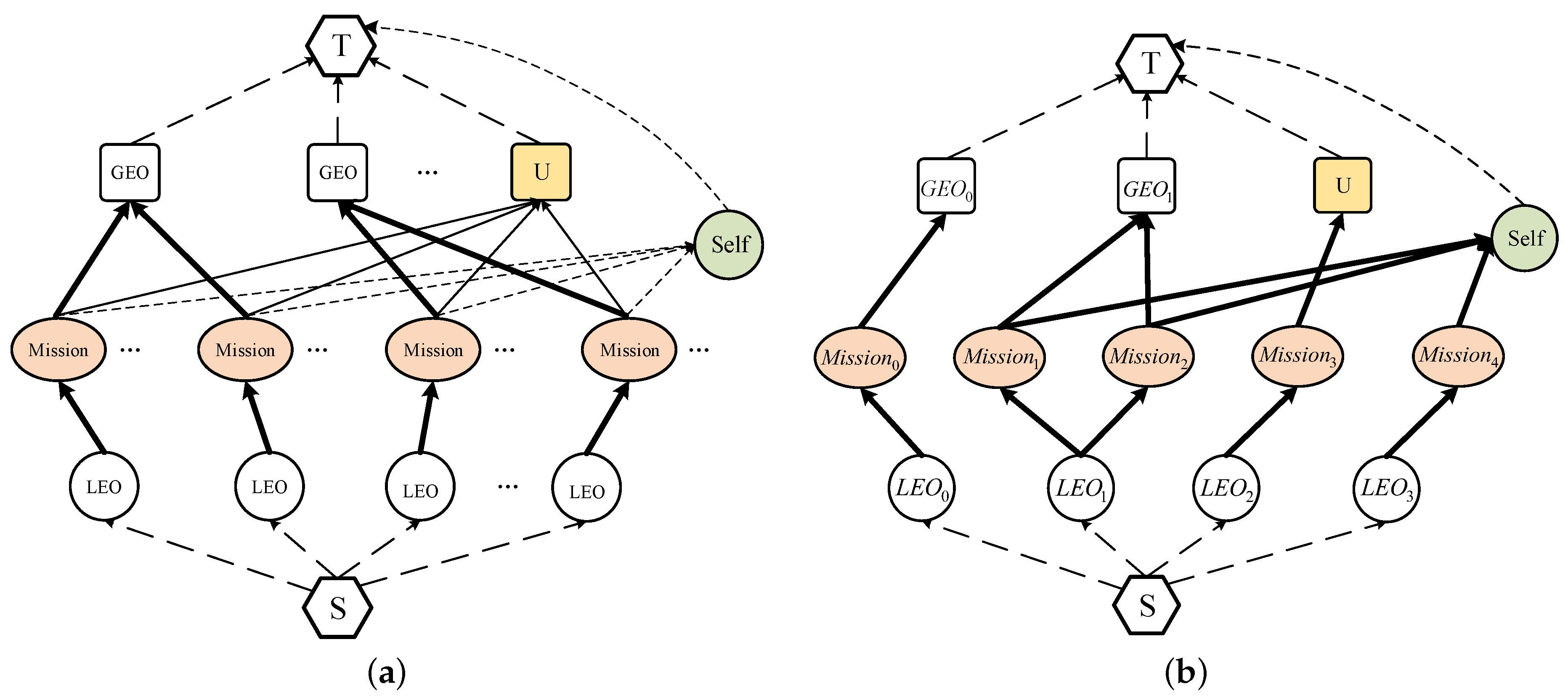
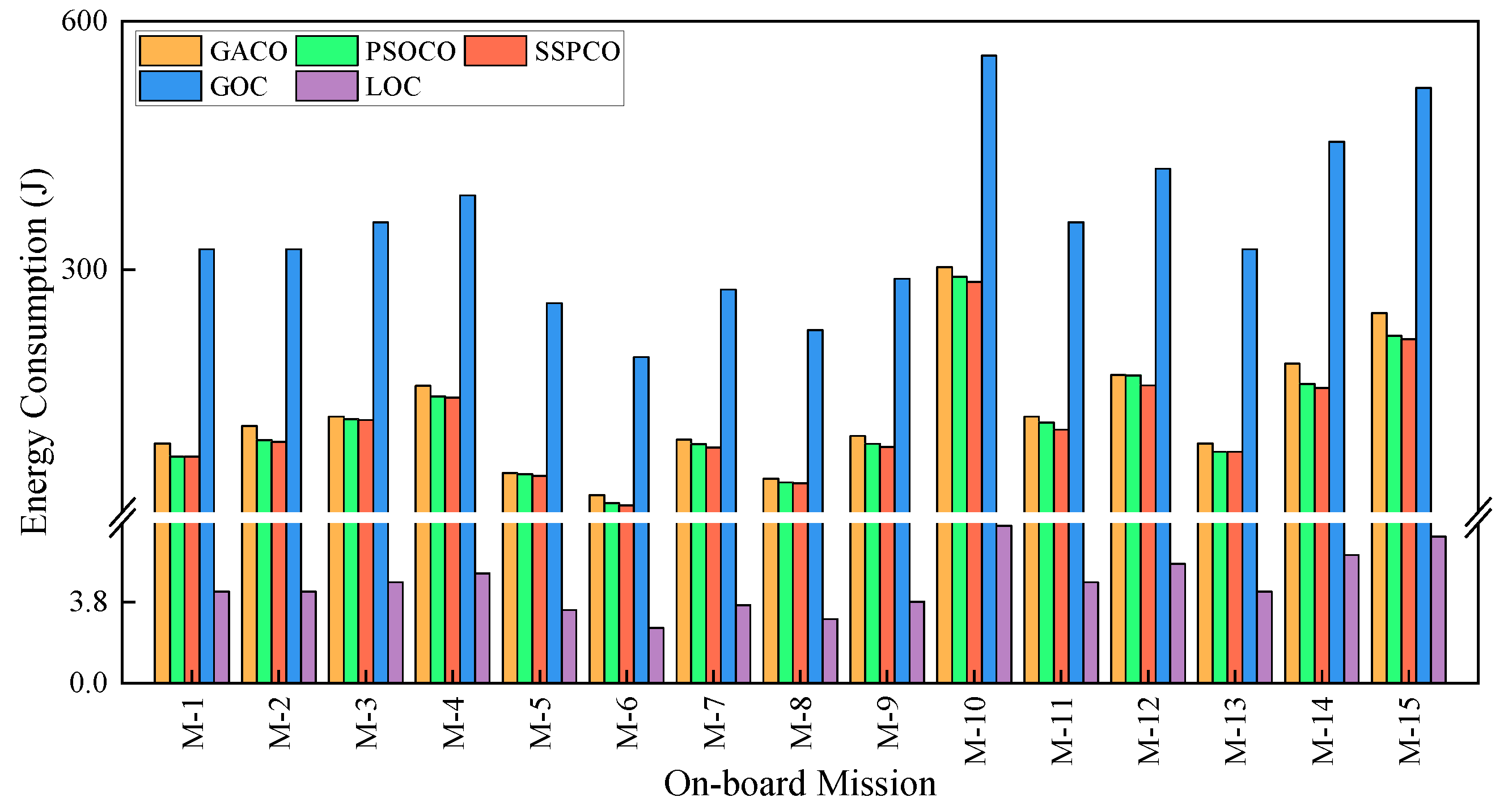




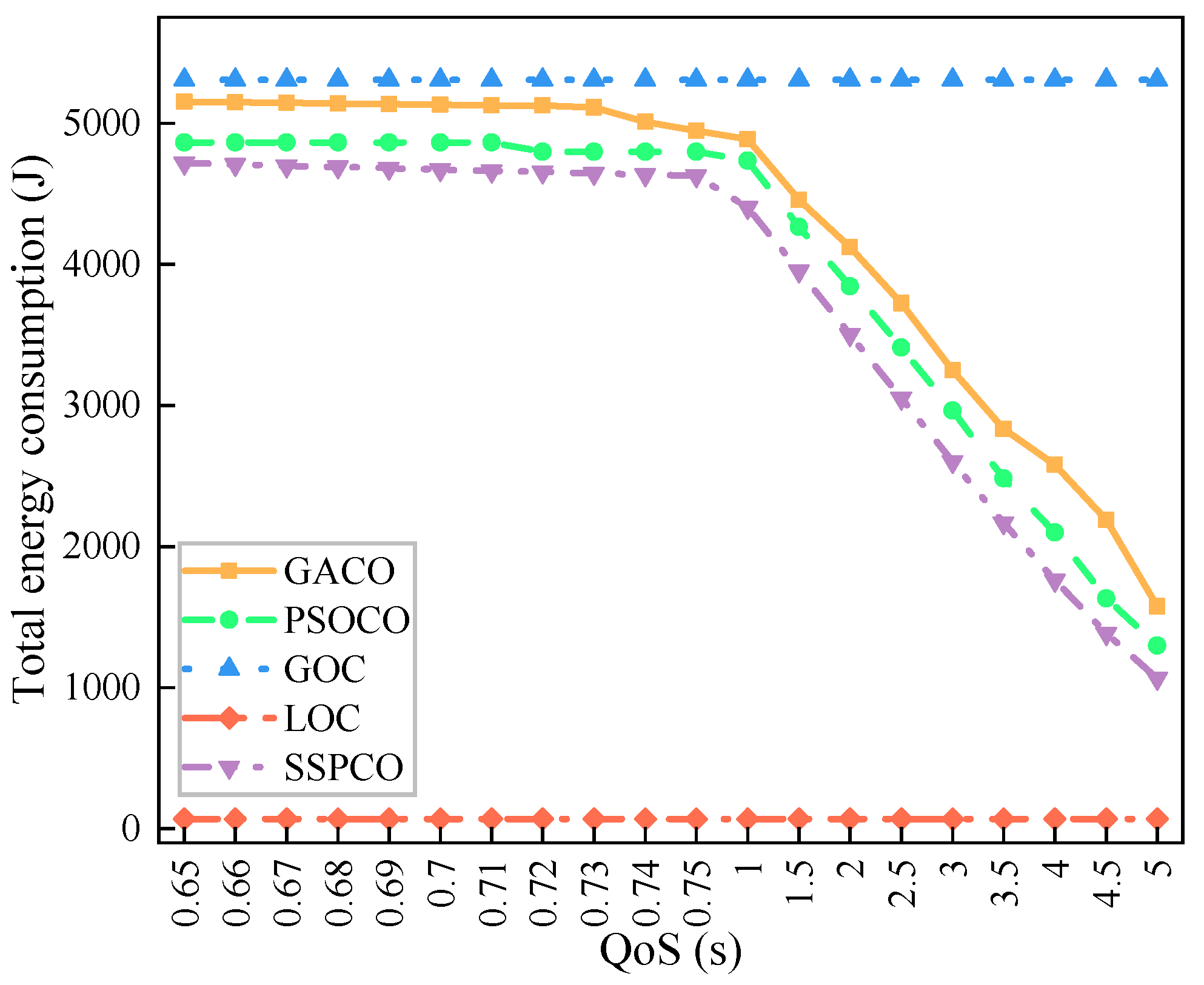

| Works | GEO | LEO | Processing Delay | Energy Consumption | QoS | Role of Satellites |
|---|---|---|---|---|---|---|
| [6] | ✓ | ✓ | ✓ | computing | ||
| [7] | ✓ | ✓ | ✓ | computing | ||
| [13] | ✓ | ✓ | computing | |||
| [14] | ✓ | ✓ | communication | |||
| [17] | ✓ | ✓ | ✓ | computing | ||
| [18] | ✓ | ✓ | ✓ | communication, computing | ||
| [19] | ✓ | ✓ | ✓ | ✓ | communication, computing | |
| [20] | ✓ | ✓ | ✓ | ✓ | computing | |
| Our work | ✓ | ✓ | ✓ | ✓ | ✓ | computing |
| Parameter | Meaning | Value |
|---|---|---|
| Radio channel bandwidth for transmitting mission from LEO satellite i to GEO satellite j | 100 MHZ | |
| Transmit power of LEO satellite i | 90 W | |
| Channel gain between LEO satellite i and GEO satellite j | 2 | |
| Gaussian noise power | dBm | |
| Processing density of mission | cycles/bit | |
| Amount of mission data | 0.5∼2.5 Gb | |
| Altitude of LEO satellite i | 1200 km | |
| Altitude of GEO satellite j | km | |
| Speed of light in a vacuum | km/s | |
| Effective switching capacitance constant determined by the chip | ||
| QoS constraints of mission | 650∼5000 ms | |
| Maximum LEO satellite processing capacity | cycles/s | |
| Maximum GEO satellite processing capacity | cycles/s |
Disclaimer/Publisher’s Note: The statements, opinions and data contained in all publications are solely those of the individual author(s) and contributor(s) and not of MDPI and/or the editor(s). MDPI and/or the editor(s) disclaim responsibility for any injury to people or property resulting from any ideas, methods, instructions or products referred to in the content. |
© 2023 by the authors. Licensee MDPI, Basel, Switzerland. This article is an open access article distributed under the terms and conditions of the Creative Commons Attribution (CC BY) license (https://creativecommons.org/licenses/by/4.0/).
Share and Cite
Lv, W.; Yang, P.; Ding, Y.; Wang, Z.; Lin, C.; Wang, Q. Energy-Efficient and QoS-Aware Computation Offloading in GEO/LEO Hybrid Satellite Networks. Remote Sens. 2023, 15, 3299. https://doi.org/10.3390/rs15133299
Lv W, Yang P, Ding Y, Wang Z, Lin C, Wang Q. Energy-Efficient and QoS-Aware Computation Offloading in GEO/LEO Hybrid Satellite Networks. Remote Sensing. 2023; 15(13):3299. https://doi.org/10.3390/rs15133299
Chicago/Turabian StyleLv, Wenkai, Pengfei Yang, Yunqing Ding, Zhenyi Wang, Chengmin Lin, and Quan Wang. 2023. "Energy-Efficient and QoS-Aware Computation Offloading in GEO/LEO Hybrid Satellite Networks" Remote Sensing 15, no. 13: 3299. https://doi.org/10.3390/rs15133299
APA StyleLv, W., Yang, P., Ding, Y., Wang, Z., Lin, C., & Wang, Q. (2023). Energy-Efficient and QoS-Aware Computation Offloading in GEO/LEO Hybrid Satellite Networks. Remote Sensing, 15(13), 3299. https://doi.org/10.3390/rs15133299





